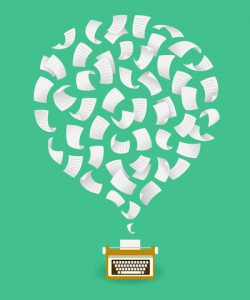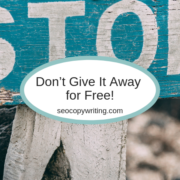Create Killer Content: Copy These Powerful Formulas
 Do a search on “sales writing” or “copywriting” and you’ll see that the body of content around it is ginormous. And that’s no surprise. After all, copywriting is the substance of all the print and digital marketing materials out there, from headlines to calls to action (and all that stuff in between).
Do a search on “sales writing” or “copywriting” and you’ll see that the body of content around it is ginormous. And that’s no surprise. After all, copywriting is the substance of all the print and digital marketing materials out there, from headlines to calls to action (and all that stuff in between).
The art and science of writing persuasive copy as we know it has been around for some time, and the principles and best practices of David Ogilvy’s day still apply today. In part 1 in our 4-part series on conversions writing, we review some evergreen resources that feature time-saving copywriting formulas, as well as helpful how-tos on creating compelling headlines and email subject lines.
Copywriting Formulas: Acronym Soup
Creating solid sales copy takes precious time and energy. To help you use both most efficiently, here are several resources for your virtual library.
The Ultimate Guide to No-Pain Copywriting (or, Every Copywriting Formula Ever)
By Joanna Wiebe via Copy Hackers
“Because only rookies write from scratch…” So begins Joanna Wiebe’s introduction to Copy Hackers’ ambitious taxonomy of copywriting formulas (as well as several templates, methods and checklists).
Beginning with the widely known AIDA (Attention-Interest-Desire-Action) model and its myriad variations to more obscure ones such as HELLYEAH (Holler-Empathize-Lambast-Legwork-Yes-Educate-Action-Handle) for long form sales letters, this guide is rich with links and examples. Definitely a keeper!
The Ultimate Guide to Copywriting
By Hassan Ud-deen via Kissmetrics
In this “ultimate guide,” author Hassan Ud-deen discusses the multiple elements that make for superlative copy. He offers a detailed description of how to apply the AIDA formula (including a great YouTube clip of Alec Baldwin’s tutorial from Glengarry Glen Ross), and delves into the psychology behind intriguing headlines, compelling openings and persuasive sales copy. Ud-deen even touches on the use of closed vs. open bullet points. A handy resource you’ll consult for most any copywriting project.
Why Most Copywriting Formulas Stink (and How to Really Write for the Web)
By Henneke Duistermaat via Enchanting Marketing
Authored by the self-described “irreverent copywriter and marketer” Henneke Duistermaat, this post takes aim at the AIDA copywriting formula. Her main objection to AIDA is the redundancy (and potential overkill) of the “attention” part. Unlike the days of print advertising when AIDA was conceived (circa 1900), you’ve already got the attention of readers — they’ve clicked on your site (several others echo this observation, including Wiebe).
Duistermaat favors the FAB (Features-Advantages-Benefits) formula (listed in Copy Hackers’ guide as “A single, solitary formula for body copy”), with the emphasis being on the benefits your product or service offers your prospect (which propels the desire called for by the AIDA model).
She also addresses the PAS (Problem-Agitate-Solution, or -Solve) formula premised on the avoidance of pain, whereby you describe a problem, stir up the emotions associated with it, then offer your solution. Regarding PAS, she quotes copywriting legend Dan Kennedy:
“When you understand that people are more likely to act to avoid pain than to get gain, you’ll understand how powerful this first formula is. (…) It may be the most reliable sales formula ever invented.”
Master This Copywriting Formula to Dominate Any Social Media Platform
By Demian Farnworth via Copyblogger
The applications for the PAS (Problem-Agitate-Solve) copywriting formula (above) are “endless”, writes Demian Farnworth, citing and linking out to examples of its use in product descriptions, landing pages and sales letters.
Farnworth then delves into how to apply the PAS formula to any text-based social media platform (rather humorously), including Twitter. He further notes that “PAS gives your writing consistency, precision, and persuasion” and is a tool you can keep handy to be an efficient writer because you “don’t have to recreate the wheel every time.”
Compelling Headlines: Key to Conversions
You’re most likely familiar with David Ogilvy’s famous quote about headlines: “On the average, five times as many people read the headlines as the body copy. When you have written your headline, you have spent 80 cents out of your dollar.”
Here are some resources to help you spend that 80 cents wisely.
A Simple Formula for Writing Kick-Ass Blog Titles
By Corey Eridon via HubSpot
Corey Eridon succinctly underscores the importance of creating truly compelling titles in prefacing his post: “Titles are what sell the content.” He continues, “They represent it in search engines, in email, and on social media.”
Guided by best practices, notably keeping the reader experience paramount by delivering on the promise of the title, Eridon’s headline-writing formula starts with the key step of distinguishing an overarching topic from a specific, working title that “guides the creation of a blog post.”
Other requisites of a stellar title include making it sexy while keeping it accurate, as deceptive clickbait titles are liable to backfire by alienating readers (they may well lose trust in you or the brand you’re representing). Additional steps entail optimizing the title for search while keeping it short, and then brainstorming with someone else to hone it to perfection. A smart, from-the-trenches formula!
#Copywriting ALERT! 902 Headline Banging Words, SRSLY
By Marty Weintraub via aimClear
aimClear CEO Marty Weintraub and his team share a list of 902 words to use when creating blog, article and ad headlines. According to Weintraub, these words are “likely to distinguish professional from amateur copy when well used.”
The list is divided into “an array of permutations” that include emotions, expletive punch words and a set of synonyms that serve as a kind of “headline-stemming lateral thesaurus.” Then to assist with ad headline and SEO title brevity, the list is color-coded according to the word’s character count. This resource is something best understood firsthand, so definitely check it out!
How To Create Headlines That Grab Attention And Convert
By Michael Brenner via Marketing Insider Group
A study conducted by HubSpot and Outbrain of more than 3.3 million blog headlines looked into those attributes that increased or inhibited content reach as measured by click-through rates (CTRs), engagement and conversions. In a nutshell, their analysis reveals that readers have become wary of clickbait, demonstrating a strong preference for transparent titles.
Michael Brenner summarizes the study’s findings, writing that headlines with the words “who” and “photo(s),” as well as those with clarifications in brackets (such as [Webinar]), generated higher CTRs, while the latter two also drove higher engagement. Bracketed descriptions were further found to generate more conversions.
The analysis found that overused sexy words such as “secret” and “magic”, those that directly address the reader (“you”) and those that convey urgency (such as “now”) all hurt CTRs by as much as 59 percent. You can download the full study (“Data Driven Strategies for Writing Effective Titles & Headlines”) at HubSpot.
Hate this Headline? You’ll Probably Share the Story.
By Barry Feldman via Kissmetrics
“While an 8-word headline of a 1300-word post represents less than 1% of the content, I’m 99% sure it will be the line that dictates the destiny of your post,” writes Barry Feldman in his own post about how to get your content shared on social media…so much so that it delivers a “sudden and pronounced spike in traffic”. The key: giving your post an emotional headline to invoke reader response by using words that pack a powerful punch.
Such “power words” can be positive (connoting pleasurable feelings), or negative (i.e., painful feelings) and there are scads of them. Feldman shares links to CoSchedule’s “cheat sheet” of over 180 power words, and to PsychPage’s equally impressively list of feeling words, both pleasant and unpleasant. He also shares a tool that scores the emotional mojo of your headlines, so you can test alternative variations. Go forth and make that headline emote!
Email Subject Lines: Stand Out in the Inbox Crowd
Email marketing is one of the most effective content marketing strategies available. You can think of email subject lines as headlines for your reader’s inbox, with their open rates the equivalent of headline click-through rates. Here are resources to assist you in persuading your readers to open your email.
The 9 Best Email Subject Line Styles to Increase Your Open Rates
By Megan Marrs via WordStream
You needn’t look farther than your own inbox to know that subscribers are inundated with emails vying for their attention. Here Megan Marrs discusses nine types of email subject lines to boost open rates: simple and no-nonsense; funny; controversial/shocking; single-word; numbers and lists; personalized; questions and other punctuation; “missing out” and other scarcity tactics; and finally, mysterious.
She then lists several general best practices for writing email subject lines, including writing ten different lines for every email and then choosing the best, keeping the character count to under 50, playing with alliteration and using CAPITALS sparingly.
Your Turn
Have you come across any evergreen sales writing resources you’d like to share? Please include them in the comments below!






“While an 8-word headline of a 1300-word post represents less than 1% of the content, I’m 99% sure it will be the line that dictates the destiny of your post,”
This isn’t too surprising given that it’s something like 80% of a website’s visitors will only read the headline. Actually, it might not be that high, but it’s really high (and really depressing if you’ve dedicated your life to creating good content only to discover that most people don’t even read it!)
Hi Todd! No, what Barry Feldman wrote isn’t altogether surprising, and the 8 of 10 stat you reference is accurate. But it needn’t be depressing — try to think of it as a competitive advantage in that you’re aware of the need to create a compelling headline, and have the information and tools to do so. You know, glass half full kind of thing. :)
Fantastic resources – each with their own links to even more fantastic resources. Love it! Can’t wait for part 2.
So glad you found these resources helpful, Lisa, thank you! And you won’t have to wait long — part 2 will post tomorrow (Thursday) morning (in the U.S., that is) :)
Such an awesome article. Totally bookmarking it. I’ve just started creating a content marketing plan for my product and will get started with the content creation shortly. Perfect article to get me started with the right tools. Thanks!!
That’s fantastic! Thanks so much for letting me know! :)
So glad you find this a helpful resource, Jayasri! Wishing you the best of luck with your product’s content marketing project — and as Heather expressed, thanks for letting us know! Makes it so worthwhile to receive such great feedback :)